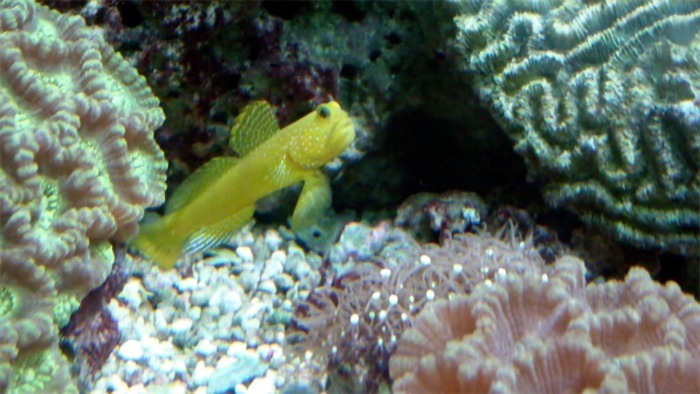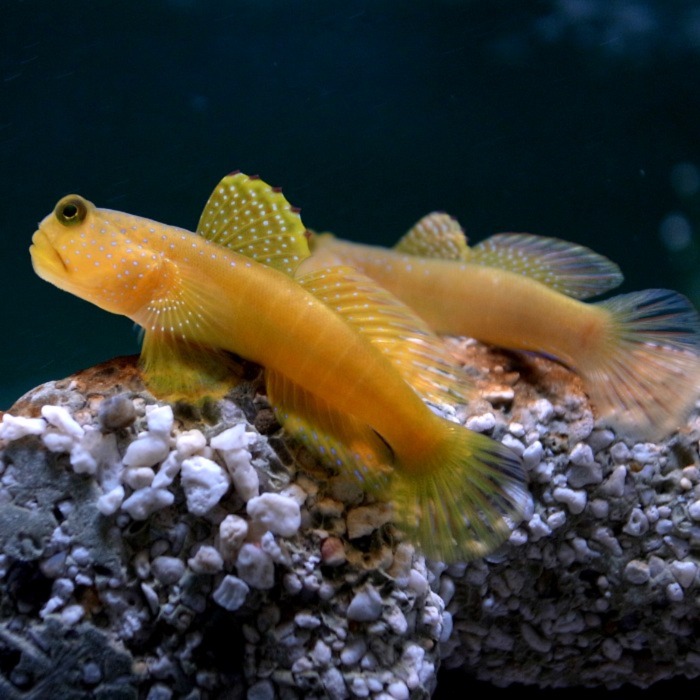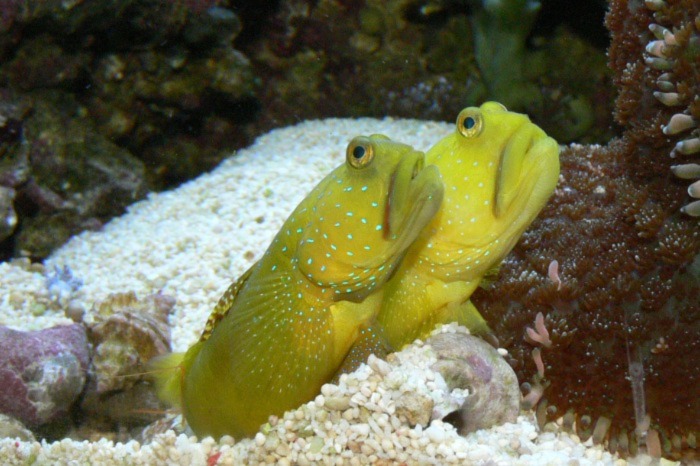Yellow Watchman Goby: Care, Size, Diet, Breeding & More
Posted by on 2/13/2023
We use affiliate links and may receive a small commission on purchases.
Comprising over 2000 different species, Gobiidae, more commonly known as gobies, is one of the largest families of fish in the world. Different species of these fish can be found living in marine, brackish, and freshwater environments, but it is the marine species that take the prize when it comes to personality and appearance.
One species in particular, the Yellow Watchman Goby, is highly sought after for its appearance and peaceful temperament. If you're considering a Yellow Watchman as your next fish, you'll want to be well-versed in its care. In this post, we'll discuss everything there is to know about the species, we'll get into their diet, the intricacies of breeding, and much more.
December's Giveaways on Light Fish
Species Summary
The Yellow Watchman Goby (scientific name: Cryptocentrus cinctus) hails from the Indo-Pacific, where it swims up to 82 feet below the surface. The species has accumulated quite a few different common names over the years, with some hobbyists referring to the fish as the Yellow Prawn Goby, Spotted Watchman Goby, and in an abbreviated form: YWG.
The species has earned the "Watchman" name for good reason. Similar to other goby fish, it forms a symbiotic relationship with shrimp that fall underneath the Alpheidae family, such as the Japanese Pistol Shrimp. As a pair, both the goby and shrimp share a burrow, which the shrimp tends to while the goby stands guard. It's a fascinating relationship to witness in the wild and is one that can be re-created successfully in an at-home aquarium.

Appearance
The Yellow Watchman Goby has frog-like eyes, large lips that form a perpetual frown, and semi-translucent fins that blend into a yellow coloration. Yellow Watchman can differ in shades of yellow, but the bodies of these fish will all be covered in small, blue iridescent dots.
Hobbyists looking to acquire a Yellow Watchman Goby often seek them for their vibrant yellow coloration, but one should be aware that as these fish mature, they can experience a dramatic change in color over 1 year. The bright yellow associated with the species can quickly turn into a dull white or gray as the fish matures.

Male vs Female
It is difficult to discern the appearances of a male and female Yellow Watchman Goby. Breeder Amy Drehmel, briefly describes her experience.
"In what I have seen of this fish, I believe they are sexually dichromatic, meaning that the male and female are different in color. With every pair that I've seen, the male is bright yellow while the female is grayish, with both having blue dots along their body. But what makes this confusing is that I have seen this fish change color in both directions. Does this mean that they are changing gender as well? I do not know." - Amy Drehmel / Reefkeeping.com
Perhaps as the species continues to be bred in captivity, we'll learn more about what to look for when spotting differences between genders.
🛒 Shop Freshwater Fish on Light Fish
Size
The Yellow Watchman Goby is a small fish, growing to an adult size of about 4 inches in length.
Juveniles will be significantly smaller, and will not reach their full size until they're about 1 year of age. Providing your goby with a well-balanced diet combined with pristine water conditions will aid in their overall growth and development.
Yellow Watchman Goby Care
The Yellow Watchman Goby makes for an excellent beginner fish, as it's relatively undemanding in its care requirements. However, these fish tend to be a bit timid, and it can be difficult to monitor them once introduced into an aquarium. They're known hiders and aren't the most active swimmers, making learning the ins and outs of their care all the more important.
In the wild, Yellow Watchman live in warm-water, tropical environments, where they pair up with pistol shrimp. You'll want to re-create these conditions as closely as possible, and with the right knowledge and preparation, it can be achieved.
Lifespan
Yellow Watchman Gobies are a long-lived species and when given the proper environment, can live for up to 10 years.
Diet, water quality, and providing a stress-free environment will give your Yellow Watchman the best chance at reaching the 10-year age mark. As with all marine fish, you'll want to keep your parameters stable and avoid any sudden swings in water chemistry.
Tank Size
Due to their size, Yellow Watchman Gobies can live comfortably in a variety of different tank sizes. We recommend an aquarium that's at least 30 gallons in size, but if budget allows, you can go even bigger.
Larger tanks often correlate to more stable water parameters, but for hobbyists looking to take on the challenge of a nano aquarium, these fish make an excellent choice.
Acclimation
Hobbyists looking to add a Yellow Watchman Goby to their display tank should have a well-established quarantine tank, where they can examine the fish for diseases and parasites over a 3-4 week period.
After the quarantine period is over, and there have been no signs of diseases or bacterial infections, the Yellow Watchman can be placed in an acclimation box , where it can adjust to the water conditions of your display tank. After 2-3 days of direct feeding in the acclimation box, you can release the goby into the remainder of your display tank.
Water Conditions
Yellow Watchman Gobies live in the warm-water lagoons of the Indo-Pacific, where oxygen-rich waters play host to a variety of different life forms and photosynthetic organisms.
In a saltwater aquarium, you'll want to replicate the following:
Specific Gravity: 1.020-1.025
Temperature Range: 72°F-78°F
Ammonia: 0ppm
Nitrite: < .2ppm
Nitrate: 5-10ppm
KH: 8-12 dKH
pH: 8.1-8.4
Maintaining these parameters, and preventing sudden changes in water chemistry will set you up for success in caring for a Yellow Watchman.
Tank Setup
Yellow Watchman Gobies will benefit from either Crushed Coral or Live Sand Substrates. Yellow Watchmans do not sift sand as frequently as Diamond Gobies, but will make a burrow regardless if an Alpheid shrimp is present in the aquarium.
Known for their shyness, an aquarium housing a Yellow Watchman Goby should have plenty of available hiding spots. Creating small caves and crevices with live rock can give your Yellow Watchman an area of refuge.
You'll also want to provide a tight-fitting lid. Yellow Watchmen are known jumpers, and a tight-lid, with no spaces for the fish to jump, is an absolute must.
In terms of flow, Yellow Watchman Gobies will hang out near the bottom of the tank, where there is little to no flow. They'll protect and guard their burrows, and will occasionally go for a swim in the middle of the water column before dropping down to rest along the substrate.
Common Diseases
Yellow Watchman Gobies are susceptible to marine velvet and ich and should be monitored carefully in a quarantine tank before moving them into your display tank.
If your Yellow Watchman shows signs of disease, you'll want to provide treatment as soon as possible before things take a turn for the worst. If left untreated, or introduced into your display tank, common diseases can be devastating to all of your tank inhabitants.
By observing any new fish in a separate quarantine tank, maintaining clean water conditions, feeding them a nutritious diet, and avoiding any aggressive tank mates that might cause stress, you can prevent a disease or infection from taking hold.
Food & Diet
Yellow Watchman Gobies should be fed a carnivorous diet consisting of Mysis shrimp, Brine shrimp, sinking shrimp pellets, and vitamin-enriched flake food at least 2-3 times a day.
Yellow Watchmen have a reputation for being picky eaters, and you'll likely need to target-feed using a pipette. In most cases, these fish will rarely venture out of their burrows to hunt down food unless they've gone a few days without feeding. If your Yellow Watchman is a bit skittish during direct feeding, take note that these fish are perfectly capable of surviving on whatever food scraps they can find on their own.
Reef Compatibility
Yellow Watchman gobies are reef safe, and make excellent tank mate options for corals such as blastos, leather corals, chalices, and torches.
However, you may want to reconsider placing corals along the sand bed, as the Yellow Watchman may knock them over when attempting to create a burrow. Corals glued to live rock should have no compatibility issues with the Yellow Watchman Goby.
Behavior and Temperament
Yellow Watchman Gobies are incredibly peaceful fish and spend most of their time lounging along the substrate or hiding in their burrow. On occasion, they may go for a short swim, but for the most part, they live a reclusive lifestyle.
Their most noticeable behavior is their symbiotic relationship with Pistol shrimp. While the shrimp tends and cares for their shared burrow, the Yellow Watchman diligently wards off potential predators.
The behavior is demonstrated in the video below, at the 16:20 mark.
Tank Mates
Without a doubt, the best tank mate for a Yellow Watchman Goby is an Alpheidae shrimp species, such as the Tiger Shrimp or Japanese Snapping Shrimp. Witnessing the relationship between these two species is one of the most interesting sights seen in nature, and is something you won't want to miss out on.
If you're considering a reef tank, corals such as brain corals and candy canes, make excellent choices, but almost any LPS (large polyp stony) or SPS (small polyp stony) coral will work well with a Yellow Watchman.
Avoid anemones, such as the black widow. Although rare, an anemone can attack a Yellow Watchman Goby.
If you're considering other fish, almost any peaceful species will do, and the following are a few options:
Avoid large aggressive fish, such as the Tessalata Eel or Blue Spotted Puffer. You'll also want to avoid adding other types of goby fish, including their own species, as this can lead to territorial disputes.
Breeding
Hobbyists looking to breed the species will be happy to know that it has been bred in captivity. While it's difficult to discern males from females, selecting a group of Yellow Watchman and observing a pair up is the first step towards successful breeding.
You'll need to have an established hatchling tank. If you're fortunate enough to have a successful spawn, raising the fry is no easy feat. Since the fry of Yellow Watchman Gobies are so small, you'll need to feed them hard-to-acquire S-strain (scientific name: Brachonius rotundaformis) rotifers for their first 14 days. After, they'll need to be transitioned to L-strain (scientific name: Brachionus manjavacas) rotifers. After the 29th day, they can be fed baby brine shrimp.
The breeding process for Yellow Watchman Gobies is covered in excellent detail, by Amy Drehmel in her post Spawning and Rearing the Yellow Watchman Goby .

Where To Purchase
Since these fish have been successfully bred, they're relatively easy to find online. We've seen them appear for sale on our Marketplace, but hobbyists should also be able to locate them at hatcheries such as ORA and some of the large online vendors.
If you're fortunate enough to have a local fish store nearby, it's always worth checking their availability since you'll save on shipping costs.
In Conclusion
The Yellow Watchman Goby certainly has a lot to offer. If you're looking for a low-key fish that stays out of the spotlight, look no further than a Yellow Watchman. When combined with a snapping shrimp, they form one of the most interesting relationships seen in nature.
Now that you've learned all about their care, do you plan on adding one to your saltwater aquarium? We're always looking for feedback on our articles, you can leave a comment below, or check out our community forum and marketplace where you can connect with others in the aquarium hobby.
December's Giveaways on Light Fish






